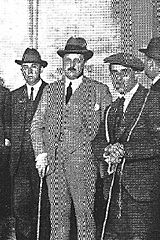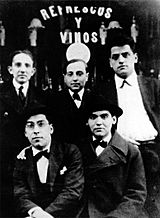José María Hinojosa Lasarte facts for kids
Quick facts for kids
José María Hinojosa Lasarte
|
|
|---|---|
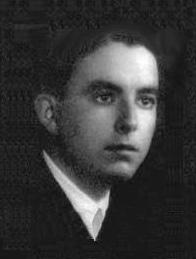 |
|
| Born |
José María Hinojosa Lasarte
17 September 1904 Campillos, Spain
|
| Died | 22 August 1936 (aged 31) Málaga, Spain
|
| Nationality | Spanish |
| Occupation | Landowner, publisher and writer |
| Known for | Poetry |
| Political party | Carlism, Agrarism |
José María Hinojosa Lasarte (born September 17, 1904 – died August 22, 1936) was a Spanish writer and politician. He is known as one of Spain's first true surrealist poets. Surrealism was an art movement that explored dreams and imagination. He was also part of a group of famous writers called the Generation of '27.
As a politician, he was involved with conservative groups. He led the Carlists in Málaga. Carlism was a political movement that supported a traditional monarchy in Spain. He also helped build the Agrarian party in Andalusia. This party focused on issues important to farmers and landowners.
Contents
Early Life and Family Background
José María Hinojosa's family, the Carvajals, were first noted in the Málaga province in the 1500s. They founded the town of Campillos. The Hinojosas, another local family, were wealthy landowners for centuries. They held important positions in the area.
Many mayors of Campillos came from the Hinojosa family. José María's father, Salvador Hinojosa Carvajal (1869-1936), was also a mayor. He was an important conservative leader in the area. In 1893, Salvador married Asunción Lasarte Xuarez (1872-1932). She came from another rich landowning family.
The couple lived on their family estates in Campillos and Alameda. They had six children, and José María was their second son.
Growing Up and Education
José María and his siblings grew up in a very wealthy home. Their mother, Asunción, was very religious. Some people say her strong Catholic beliefs were very strict. From a young age, José María was serious and loved to read. He also had a taste for fancy things.
In 1915, he started school at the Colegio de San Fernando in Málaga. He might have also attended the Jesuit college of San Estanislao. He finished high school in 1920. From 1921 to 1922, he studied law at the Universidad de Granada. In 1923, he moved to Madrid to continue his law studies.
He spent time in Paris from 1925 to 1926. This was either to improve his French or to prepare for a job in diplomacy. Hinojosa returned to Spain and finished his law degree in 1926. In 1927, he served in the military in Madrid. He completed his service in 1928.
Travels and Personal Life
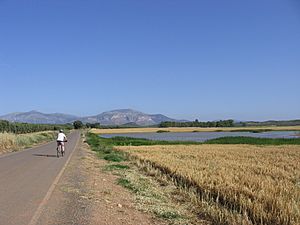
From 1928 to 1930, Hinojosa lived a free-spirited life in Málaga. He also traveled a lot around Andalusia and other countries. He visited France, England, and even Nordic countries. He also toured the USSR, which was very unusual for a Spaniard at that time.
He lived partly with his family and started working in their family business. This included managing land and industrial activities. Around this time, he fell in love with Ana Freüller Valls. She was from a noble family and was a local aviation pioneer. Their relationship was complicated.
Hinojosa hoped to marry her, and Ana later said they almost did. However, she also said they were just close friends. Their relationship continued until Hinojosa's death. He never married and had no children.
Literary Career
In the early 1920s, Hinojosa began his writing career in Málaga. Emilio Prados was his writing mentor. In 1923, Hinojosa helped start Ambos, a literary magazine. This magazine explored new art styles like dadaism, futurism, and expressionism. It published poems by its founders and other writers like García Lorca.
Ambos only printed four issues and was mostly read by friends. Hinojosa's writing improved when he was in Paris. There, he joined a group of young Spanish artists. This group included Prados, Lorca, Buñuel, and Dalí. Hinojosa's poetry was described as surrealist. His poems, published in magazines and books from 1925 to 1927, showed his growing talent.
Surrealist Peak and Publishing
Hinojosa's writing reached its highest point in 1928. He published two more books that showed his surrealist style. In the late 1920s, he became involved with Imprenta Sur, a publishing house in Málaga. He also helped launch Litoral, another avant-garde magazine in Málaga.
He worked as an editor and poet for Litoral. He was especially involved in the 1929 issue dedicated to Góngora. Hinojosa also invested money in the magazine and joined its board. He later planned to start a magazine focused only on surrealism.
Because of his poetry and free-spirited lifestyle, he gained a reputation as an unusual and rebellious person in Málaga. His writings sometimes had anti-religious themes. He enjoyed shocking people, including famous thinkers like Valle-Inclan. He was often helped by friends like Dalí and his partner Gala.
Relationships with Fellow Artists
Hinojosa's friendships with his avant-garde artist friends were complicated. Even though he was part of their inner circle, some of them made fun of him. They called him a rich "señorito" (a wealthy young man) and said his poetry was bad. Writers like Diego, Lorca, Dalí, and Buñuel sometimes criticized him.
Many of them saw him more as a sponsor than a fellow writer. They stayed at his home, traveled with him, and ate at his expense. They found it useful to be friends with the "bohemian with the current account." Some paid him back with their own artwork. This is how Hinojosa collected paintings by Miró, Picasso, Gris, Dalí, and Bores.
Most literary critics either ignored his work or said it wasn't very good. It's unclear if these complex relationships affected the strong and dramatic tone of his last poetry book. This book was meant to be published in 1930 but was released in early 1931. It was his last work of literature. Some believe he decided to stop writing poetry after that.
Works and Style
Hinojosa wrote about 200 poems. Most of them were short, and some were very short. He also wrote 14 short prose texts that are hard to categorize. His attempts at writing plays and novels have not survived. All his works were written between 1923 and 1930. During his lifetime, they were published in six small books and a few magazines.
His writing career is seen as a journey. It started with early works, reached a peak with surrealism, and then declined. Another expert divides his work into four stages: descriptive, transitional, autobiographical, and catastrophic.
Early and Transitional Poetry
His early poems, like those in Ambos and Poema del Campo (1925), were about rural myths. They often described a peaceful, bucolic countryside in a lyrical way. Some call his style "neopopulism" because of its folk feel. Others mention "purismo" and "cubismo." Experts note that he combined old traditions with new, modern ideas. He used new and sometimes wild metaphors.
Poesía de perfil (1926), published in Paris, contained poems that explored a mix of fantasy and real settings. His descriptive style changed to a more lyrical one. He wrote about many different themes, often focusing on journeys and exploration. This book started to show a dream-like and surrealist approach, though it wasn't fully developed yet.
La Rosa de los Vientos (1927), published in Málaga, was a small collection of just 19 poems. These poems focused on imaginary trips to exotic places and into his own mind. The book talked about space, mystery, and wildness. It often referred to ancient and popular culture. The style was sometimes very complex, mixing different rhyme patterns and syllable types. It is described as a blend of Spanish Ultra, French surrealism, and Chilean creationism.
Mature and Final Works
Two books from 1928 are considered Hinojosa's most mature works: Orillas de la luz and La Flor de Californía. La Flor de Californía is thought to be the first surrealist work in Spain. It is his only prose book. It contains seven dream stories and seven dream-like texts. The stories have a strange, connected flow, while the other texts are closer to what is called automatic writing.
The prose explores typical surrealist themes. These include anti-religious ideas, black humor, and hidden dream-worlds. It also contains many visions of disaster. The book is very personal, showing his own search for meaning. La Sangre en Libertad (1931) was similar to La Flor but even more extreme. It had stronger anti-religious jokes and more scenes of disaster. This book showed his writing evolving towards free verse and bold experiments with language.
Shift to Politics
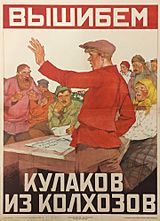
Until the early 1930s, Hinojosa was not involved in politics. His writing, especially its anti-religious parts and his challenges to traditional society, seemed to suggest he leaned left. He even reportedly thought about making his family's land into a shared farm. He might have visited the USSR to learn about their collective farming system, called a Kolkhoz.
His later change to right-wing politics is a mystery. Some experts think his trip to the USSR started this change. Others believe that getting involved in his family's business, which had many worker strikes, might have changed his views. It is also suggested that his relationship with Ana Freüller, who disliked his poetry, might have influenced his political shift.
Some wonder if his artistic friends' unclear opinions of him made him feel like he belonged somewhere else. This might have caused him to react strongly. Finally, some people believed his surrealism was just a whim of a rich young man.
Joining Right-Wing Groups
Hinojosa's biographers say he started to support right-wing ideas after 1928. Or, the change happened between 1925 and 1930. He was already very doubtful of the new government when the Republic was declared in 1931. He became a local judge in Campillos under unclear circumstances. This job might have exposed him to social unrest.
By July, he was helping to create a provincial organization for landowners. Later that year, he became secretary of the new Federación Provincial de Sindicatos Agrícolas de Málaga. He also started writing articles about agriculture and conservative ideas for the local newspaper, La Unión Mercantil. At this time, Hinojosa was interested in the Partido Nacionalista Español. His former surrealist friends worried he was about to start a local branch of a "fascist party."
Hinojosa eventually chose another right-wing group. José María Lamamié de Clairac, a landowner and a friend of his father, was involved in both farmer groups and Carlism. He convinced Hinojosa to join the Carlists. From January 1932, Hinojosa attended Comunión Tradicionalista meetings.
In July 1932, he gave a speech praising Catholic women who stood against liberalism. In early August, he organized Carlist meetings in Málaga himself. He resigned from his judge position. Hinojosa became known as a strong "derechista" (right-winger) in the Traditionalist press. Even though he wasn't involved in the Sanjurjada (a failed military coup), he was arrested afterward. He spent two weeks in prison with other Carlists who were involved. This experience made him even more dedicated to his political beliefs.
Political Roles and Activities
After being released from jail in late 1932, Hinojosa continued to organize Carlist meetings. In early 1933, he became one of the most active Traditionalists in the area. In March, he became the leader of the local Carlist organization. In many speeches, he honored Carlist heroes. He promised to free Spain from what he called a Liberal-Marxist revolution. He also praised Sanjurjo, who he said bravely sacrificed himself for Spain. Some of his speeches had hidden anti-Republican messages.
At the same time, Hinojosa worked hard to build farmer groups. He held meetings, gave speeches, and wrote articles. As a Carlist representative, he also helped lead the Málaga branch of Acción Popular. He represented all three groups when he ran in the 1933 election. He was part of a large right-wing alliance. Some newspapers called him a Carlist, others an Agrarian, and some a candidate of Acción Popular. Experts usually call him a Carlist. He received 21,662 votes but did not win a seat in the Cortes in the first round. He withdrew before the second round. In 1934, he became a member of the board of Editorial Tradicionalista, a new publishing house for Carlist ideas.
Agrarian Focus
From early 1934, there is less information about Hinojosa's Carlist activities. Instead, most sources point to his involvement with the Partido Agrario Español (Spanish Agrarian Party) and its farmer groups. He continued to write for La Unión Mercantil about three times a month. He also kept helping to manage his family's estates and started working as a lawyer.
Some sources say he defended farmers from Campillos who were accused of crimes. However, the press reported that he called the police against people who occupied his estates. This led to a violent conflict. In late 1934, the Agrarian minister José María Cid appointed Hinojosa to a government position related to water services in Southern Spain. He resigned in April 1935, when the Agrarians left the government. By then, he was the provincial leader of the Partido Agrario. He ran unsuccessfully as their candidate in the 1936 elections.
Death
After the Popular Front won the 1936 election, Hinojosa was very active in farmer groups. He demanded that public order be restored and that rural labor contracts be reviewed. In May, he was arrested after disturbances in Campillos, though he was still working as a lawyer.
During the July 18 coup in Málaga, he might have helped the military. The next day, he went into hiding with his father and brother. They thought about escaping to Gibraltar. However, before they could leave, the three of them were captured on July 24. They spent the next month in a provincial prison.
On August 22, a workers' militia stormed the prison. They dragged 43 prisoners out, shot them at the local cemetery, and buried them in a mass grave. Hinojosa's body was never officially identified. After the Nationalist forces took Málaga, the bodies were dug up. Salvador Hinojosa, José María's father, was recognized because of a handkerchief in his pocket.
See also
 In Spanish: José María Hinojosa para niños
In Spanish: José María Hinojosa para niños
- Surrealism
- Carlism
- Spanish Agrarian Party


